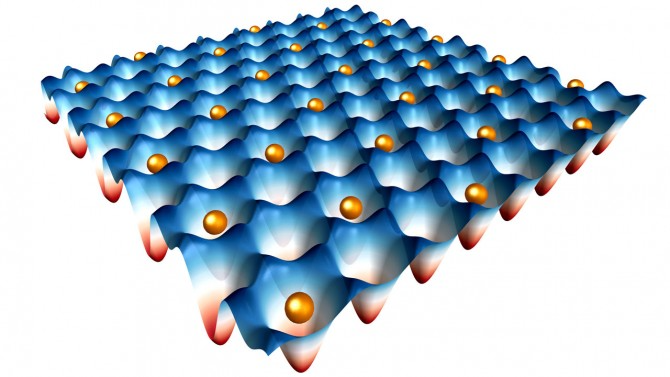Nov 12 2020
A research collaboration led by Cornell University has designed a method to pile two-dimensional semiconductors and trap electrons in a recurring pattern that develops a unique and long-proposed crystal.
 Cornell researchers stacked two-dimensional semiconductors to create a moiré superlattice structure that traps electrons in a repeating pattern, ultimately forming the long-hypothesized Wigner crystal. Image Credit: Cornell University.
Cornell researchers stacked two-dimensional semiconductors to create a moiré superlattice structure that traps electrons in a repeating pattern, ultimately forming the long-hypothesized Wigner crystal. Image Credit: Cornell University.
The study titled “Correlated Insulating States at Fractional Fillings of Moiré Superlattices” was published in the Nature journal on November 11th, 2020. The lead author of the paper is postdoctoral researcher Yang Xu.
The project emerged from the shared laboratory of Kin Fai Mak, associate professor of physics in the College of Arts and Sciences, and Jie Shan, professor of applied and engineering physics in the College of Engineering, the co-senior authors of the paper.
Both Mak and Shan are members of the Kavli Institute at Cornell for Nanoscale Science; they came to Cornell via the provost’s Nanoscale Science and Microsystems Engineering (NEXT Nano) initiative.
Theoretical physicist Eugene Wigner was the first to propose a crystal of electrons in 1934. He suggested that when the repulsion caused by negatively charged electrons—known as Coulomb repulsions—controls the kinetic energy of the electrons, a crystal would be developed.
Researchers have attempted several techniques to inhibit that kinetic energy, for example, placing electrons under an enormous magnetic field, approximately a million times that of the Earth’s magnetic field. Overall crystallization stays elusive, but a new technique has been identified by the Cornell team for achieving it.
Electrons are quantum mechanical. Even if you don’t do anything to them, they’re spontaneously jiggling around all the time. A crystal of electrons would actually have the tendency to just melt because it’s so hard to keep the electrons fixed at a periodic pattern.
Kin Fai Mak, Associate Professor of Physics, College of Arts and Sciences, Cornell University
Therefore, the team came up with a solution to construct a real trap by piling two semiconductor monolayers, tungsten diselenide (WSe2) and tungsten disulfide (WS2), developed by collaborators at Columbia University.
Every monolayer possesses a somewhat different lattice constant. Upon pairing the monolayers together, they make a moiré superlattice structure, which primarily looks similar to a hexagonal grid. Then, the team placed electrons in particular sites in the pattern. Similar to what they discovered in an earlier project, the energy barrier present between the sites locks the electrons in their position.
We can control the average occupancy of the electrons at a specific moiré site.
Kin Fai Mak, Associate Professor of Physics, College of Arts and Sciences, Cornell University
The complex pattern of a moiré superlattice, together with the jittery nature of electrons and the necessity to place them into a very particular arrangement, made the team seek help from Veit Elser, professor of physics and a co-author of the paper, who estimated the ratio of occupancy by which various arrangements of electrons will be self-crystallized.
But the difficulty with Wigner crystals is not just making them but also observing them.
You need to hit just the right conditions to create an electron crystal, and at the same time, they’re also fragile. You need a good way to probe them. You don’t really want to perturb them significantly while probing them.
Kin Fai Mak, Associate Professor of Physics, College of Arts and Sciences, Cornell University
The researchers developed a new optical sensing method that involves placing an optical sensor close to the sample and interspersing the entire structure between insulating layers of hexagonal boron nitride, made by collaborators at the National Institute for Materials Science in Japan.
Since the sensor is isolated from the sample by around 2 nm, it does not disturb the system.
The new method allowed the researchers to notice several electron crystals with different crystal symmetries, from triangular-lattice Wigner crystals to crystals that self-aligned into dimers and stripes. Therefore, the researchers showed that simple ingredients could be used to develop complex patterns—as long as the ingredients stay still for a longer period.
The study co-authors are scientists from Columbia University and the National Institute for Materials Science in Japan.
The study and device fabrication were financially supported by the U.S. Department of Energy, the U.S. Office of Naval Research, and the David and Lucille Packard Fellowship.
Journal Reference:
Xu, Y., et al. (2020) Correlated insulating states at fractional fillings of moiré superlattices. Nature. doi.org/10.1038/s41586-020-2868-6.